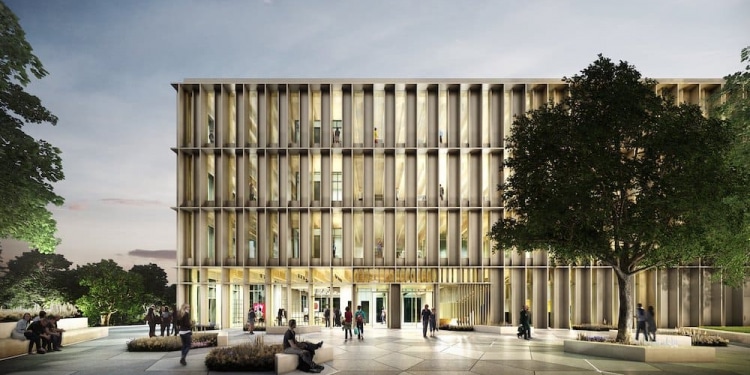Following a £54.3 million investment in a new biomedical research building, the University of Warwick required a fully functioning emergency evacuation system to cater for up to 700 people. The maintenance team opted for Eaton’s ZB-S system to provide a solution.
The five-storey building can cater for up to 700 people and includes a lecture theatre, as well as several social and collaborative spaces. The relatively small team required an emergency evacuation solution that didn’t require regular maintenance and was easy to troubleshoot, with access to luminaries often challenging due to high ceilings in areas such as the atrium and lecture theatre.
The University opted for Eaton’s ZB-S central battery system and escape route luminaires, as it had already installed these in nearly 50 of its other buildings. The system uses CGVision technology to monitor all 710 luminaires from a central PC.
Eaton’s ZB-S system provides a reliable power supply (230 V AC/220 V DC) to the escape route luminaires. It automatically tests itself and individually monitors each luminaire using CEWA Guard technology (CG) via the power supply cable, without the need for an additional data cable.
ZB-S also allows the installer to program the switching mode of every connected CG-S luminaire within a 50/60 Hz supply network via the system’s controller. This enables the combination of switched maintained, maintained and non-maintained lighting modes in a single final emergency-lighting circuit.
Remote monitoring minimises the need for manual inspections – a key aspect in the design in a building where sensitive material is held, as well as reducing the workload on the maintenance team.
In the event of a circuit fault or any other issue, the system indicates the location of the fault and sends an email and/or text message to the maintenance team. Individual reports of ongoing maintenance across the University estate are recorded, while a log of all testing is held as a legal requirement.
Paul Holland, Design Engineer, University of Warwick: “The Eaton system saves our maintenance team hours of time in terms of testing and troubleshooting and gives us peace of mind that we can identify the location of any fault to prioritise and address it. This is a great system to have at your disposal if you are dealing with multiple buildings and enables us to minimise disruption for their occupants.”
NG Bailey, the electrical and mechanical contractors for the project, worked with Eaton to design, install and commission the system in the new building. The central battery connects to a series of substations on the different floors with multiple final emergency-lighting circuits. Each circuit can connect up to 20 exit sign luminaires, reducing the cost of installation as there is no need for separate data cables. After installation, each substation/luminaire is assigned its own address so that it can be identified and monitored remotely.
According to Steve Butler, Project Manager at NG Bailey, “The phased installation of the luminaires was clearly structured, and both the installation and commissioning proved very simple. One supply line provides power and data from the central battery system to each luminaire, and after they were installed, Eaton’s commissioning engineer simply uploaded the luminaires’ individual switching modes using a laptop.”
The installation took place in several phases, with the deliveries of luminaires and substations coordinated by a local electrical wholesaler.



